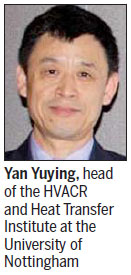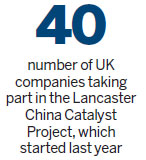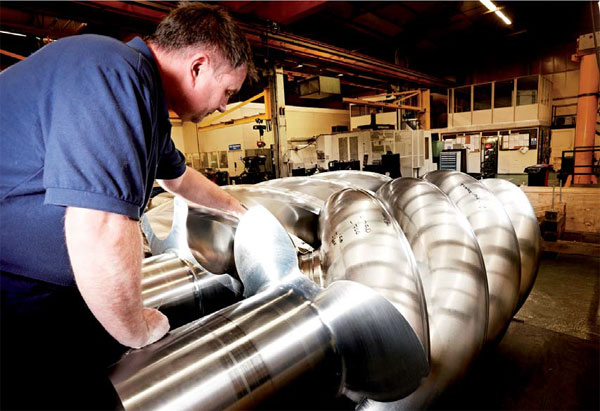Acquiring knowledge, building strength

Chinese companies are investing heavily in research and development in Europe, drawing on the continent's plentiful high-technology and human resources to help them move up the value chain and internationalize their operations.
They often establish R&D laboratories through existing subsidiaries in Europe or by buying European companies with existing R&D capabilities that they can add to.
One of these Chinese companies is the telecommunications giant Huawei. Renato Lombardi, vice-president of Huawei's European research center, says the company allocates its R&D resources with the aim of making the most of what each country's human resources and social networks offer.
| Most of the R&D that Precision Technologies does is on advanced machine tools. Photos provided to China Daily |
In Europe the company has R&D centers in Belgium, the United Kingdom, Finland, France, Germany, Ireland, Italy and Sweden, and it allocates a portion of its R&D work to each country based on its expertise.
The center in Italy focuses on microwave research, which is critical in connecting mobile base stations and networks. Before the center was set up in 2008, Huawei outsourced its microwave business to other companies, Lombardi says. Realizing the importance of developing microwave technology, it decided to set up the Italian center, and Lombardi says that in-house microwave technology has greatly benefited Huawei's global operations.
R&D in Europe is particularly important because Huawei has many joint R&D projects with key customers, and through them the company can stay abreast of the latest trends in the industry, he says.
In the UK, Huawei has R&D sites in Bristol, Cambridge and Ipswich.
Xu Bin, director of Huawei's UK research effort, says: "This long-term R&D investment generates the breakthroughs that are to be the basis for our revenue streams in the future."
The center in Ipswich was set up as a result of Huawei's buying the Centre for Integrated Photonics Ltd, a British research laboratory, in 2012.
"The acquisition was crucial to our UK R&D growth," Xu says. "Since we acquired the center, we have increased investment in its facilities and integrated it closely into the innovation process within Huawei. The center helps our teams around the world design and test the innovations that are vital to our core set of telecommunications products."
Chinese medical equipment company Mindray gained an R&D center in Sweden when it bought Datascope, a US company, in 2008.
However, the company's R&D activities extend beyond this center, because it is also using its European sales force as a way of gathering information on customer needs, which is then used by its R&D centers in China to further develop products, says Su Lei, country manager for Mindray UK.

R&D is at the heart of Mindray's corporate culture because technology in the medical industry advances rapidly, Su says, and the company needs to keep up with the latest trends in the industry to stay ahead of its competitors.
Mindray consistently invests 10 percent of its annual sales revenue in R&D, which is high by industry standards. The company's R&D team accounts for about one-third of the total workforce.
The R&D center in Sweden has great expertise in anesthesia monitoring devices, Su says. "We greatly value this R&D center from a strategic perspective, and we use it to research pioneering technology in relation to the medical industry because Europe has an advantage in breakthrough technology research."
Mindray's R&D centers in China focus more on developing new products and commercializing technology for production. There is strong collaboration between the team in Sweden and the Chinese R&D centers, Su says.
As with Mindray's access to R&D capability in anaesthesia through the Datascope acquisition, the 2008 purchase by the Chinese company Zhuzhou CSR Times Electric of the British semiconductor company Dynex Semiconductor Ltd has given it crucial R&D capability in chip technology, which is crucial for the railway industry.
That helped it develop its own version of a high-efficiency switch called an insulated-gate bipolar transistor, a key transport industry component.
Zhuzhou CSR Times Electric was part of railway equipment manufacturer CSR Corporation, which merged with another manufacturer, CNR Corporation in June, to create CRRC Corporation, and had imported these switches from leading international suppliers in Europe and Japan for many years.
CSR wanted the competitive advantage of in-house competence in designing and making such semiconductor technology.
Paul Taylor, CEO of Dynex, says the acquisition has greatly helped his team increase its R&D capabilities through financial support, technology sharing and assistance with commercialization.

Since the acquisition, Dynex has expanded technologically in two stages. In the first phase, 7.8 million pounds ($12 million; 10.7 million euros) was invested in R&D starting in 2010, of which Zhuzhou CSR Times Electric contributed 80 percent. In the second phase, which began last year, 20 million pounds was invested in R&D, with 80 percent of that again coming from Zhuzhou CSR.
The investment has enabled Dynex to build a new R&D center, which opened in 2012. Dynex's R&D staff has grown from 12 before the acquisition to 55.
Taylor says the access to skilled engineers from Zhuzhou CSR Times Electric, who are seconded to Dynex, is also valuable for both the development of new technology and technology transfers from Dynex to Zhuzhou CSR.
"The fact that they have been here and understand the way we work as a team also means they can help to coordinate a lot of the partnership we have with our parent company in the longer term," he says.
More recently, Zhuzhou CSR Times Electric has set up a team of about 10 to conduct research and development on the drivetrain sub-assemblies of electric vehicles, which is based at Dynex's R&D center.
The new team will look into how the semiconductor switching technology they developed for trains can be applied to electric cars, hoping to develop a technology that can be sold to carmakers.
Zhuzhou CSR is doing the work at Dynex because the semiconductor technology is at the heart of the drivetrain system, so working with Dynex's existing capability can better deliver cost-effective and well-tailored products for customers, Taylor says.
Another case of synergy is Chongqing Machinery & Electric Co's acquisition of Manchester-based Precision Technologies Group in 2010. Neil Jones, group business development director at Precision Technologies, says the Chongqing company has demonstrated its regard for research and development by allowing it to invest 12 to 15 percent of revenue in R&D.
"Chongqing Machinery & Electric has realized that R&D is at the heart of what we do today and for the future," he says. "They allow us to invest in R&D to improve our processes, quality and accuracy, which is at the forefront of precision engineering and technology."
Most of the R&D that Precision Technologies does is on advanced machine tools such as the Zenith, a precision helical grinding machine that the company developed through an intensive effort.
The investment has paid off because the machine is significantly better than similar machines sold by competitors, and as a result, Precision Technologies has taken customers away from rivals, Jones says.
Meanwhile, Precision Technologies also works closely with the parent company subsidiary Chongqing Machine Tool Group Co to make compressor rotors for the Chinese market, which involves extensive joint R&D and knowledge sharing.
Often, research and development is crucial for a Chinese company to reap all the benefits of an acquisition, as shown by the Chinese automotive manufacturer SAIC Motor Corp Ltd, which bought technology relating to the Rover 75 and Rover 25 models after the British carmaker MG Rover collapsed in 2005.
To help SAIC fully integrate MG Rover's intellectual property into its own cars, the British consulting firm Ricardo Group offered to provide an R&D center in Britain to train SAIC's engineers.

The center, in the English Midlands, employed about 200 engineers, many of whom were former MG Rover employees. The center was later integrated into SAIC's UK operation.
Mark Garrett, chief operating officer of Ricardo Group, says his company's help in setting up the R&D center enabled the intellectual property that SAIC had bought from MG Rover to be applied quickly to create new products, such as the Roewe 550.
A new automobile with MG technology, Roewe 550 was fully compliant with European Union crash performance standards and was launched in the China market within three years.
In addition, many Chinese companies have set up joint R&D projects with European universities, leveraging the expertise of these universities' researchers. Once new research is developed on campus, the companies take the technology into their own laboratories for product commercialization.
One example is the participation of Huawei in the University of Surrey's 5G Innovation Centre, launched in 2013, as a founding member and industry partner. It is investing 5 million pounds in the center and has provided expertise in and equipment for testing by the center.
Keith Robson, CEO of the center, says as the R&D work focuses on developing a common standard for 5G technology, having an important telecommunications company like Huawei as a member is important because it means Huawei's 5G standards will fit well with the global standard as it develops.
Without a common standard, there is risk of 5G technology fragmentation, meaning that individual industries, such as automotive, financial services, healthcare and telecommunications, wouldn't benefit from the integration of 5G.
Robson says the Huawei equipment is of a quality that only a few companies in the world can deliver.
The Huawei team is now at the University of Surrey helping with a large-scale installation of advanced 4G equipment as part of the innovation center's unique 5G test facility, which will open at the University's Guildford campus in September. Huawei soon will also provide the center some of its 5G equipment, which represents advanced and newly developed technology.
The University of Nottingham is also conducting R&D for electric and hybrid vehicles with Chinese automotive manufacturer FAW Group Corp, focusing on thermal management and improving thermal efficiency.
The thermal management research focuses on keeping the temperature of electric car batteries within a range for optimal operation, which will also improve safety and prolong the lifespan of batteries, says Yan Yuying, a professor of thermofluids engineering and head of the HVACR (heating, ventilating, and air conditioning) and Heat Transfer Institute at the University of Nottingham.
He says the battery is the most important and most expensive part of an electric car, accounting for over half of the car's overall cost. Thermal management of the battery system is directly relevant to the cost of the car.
"The optimal operating temperature of the battery in an electric car is between 25 C and 40 C. But the battery environment is often as high as 60 C to 70 C in the summer, and in some parts of China where the climate is cold in the winter the battery starting temperature can be much lower than 25 C. Sometimes, for example on motorways, when the car is fully accelerating, the battery can be hotter than 40 C," Yan says.
The second aspect of the research, which focuses on energy harvesting or improving thermal efficiency, aims to recover a larger percentage of energy, retrieving it from exhaust gases, for example, and turning it into electric energy.
He says with the current engine technology for hybrid vehicles, less than 30 percent of the fossil fuel consumed by the engine is turned into useful energy for the wheels, and a small fraction of this energy is then turned into electric energy.
However, because more than 70 percent of the original energy is lost through the exhaust and other heat losses, recovering this energy and turning it into electrical power could be beneficial.
Yan says his researchers have finished the first phase of work, which has produced viable technology. They have just started the second stage of collaboration with FAW, which focuses on further development of the technology and commercializing it for testing and mass production in FAW's vehicles.
The second phase will take place in both Nottingham and China with much closer collaboration with FAW's R&D center.
Lancaster University is pioneering a project that brings together Chinese and UK businesses for joint R&D projects in academia, with support of the university's academics and students. The Lancaster China Catalyst Project started last year. More than 40 UK companies now take part.
Mark Beresford, the program's UK-China project manager, says the matchmaking process that brings Chinese and British companies together is important, and his team seeks to give companies support on both sides through facilitating trust, confidence, mutual respect of differences, flexibility in approach, and overcoming language and cultural barriers.
"For collaborations to be successful and add value long term, UK-China company partnerships need to be grounded in a strong commercial logic and not just set up for the purposes of a short-term project," he says.
The project focuses mainly on small and medium-sized businesses that might otherwise lack the resources to invest in cross-border R&D collaboration.
But despite booming Chinese R&D investment in Europe, many challenges remain. In terms of acquiring R&D capability through mergers and acquisitions, it is crucial for Chinese firms to understand how much of a target's technology and R&D capability is included in the blueprint of contracts, says Fu Xiaolan, professor of technology and international development at the University of Oxford.
In addition to the codified knowledge that can be specified in contracts, it is vital to understand there may be "passive knowledge" - experience and knowledge held by senior managers and key employees of a company - that is worth trying to acquire, too, Fu says.
cecily.liu@chinadaily.com.cn
(China Daily European Weekly 09/05/2015 page6)
Today's Top News
- Japan tempting fate if it interferes in the situation of Taiwan Strait
- Stable trade ties benefit China, US
- Experts advocate increasing scope of BRI to include soft power sectors
- New engine powers cargo drone expansion
- China to boost green industry cooperation
- Manufacturing PMI rises in November































